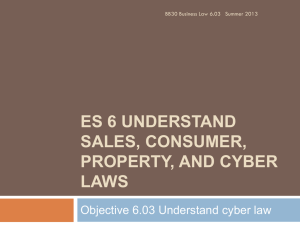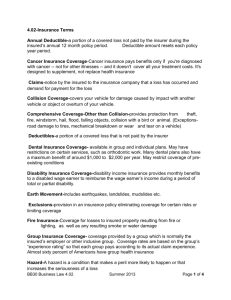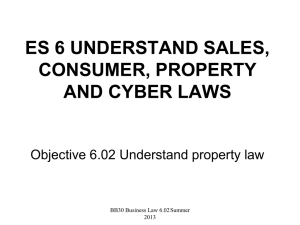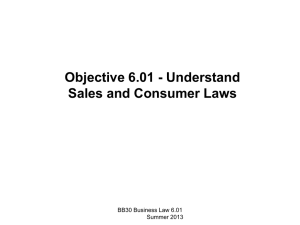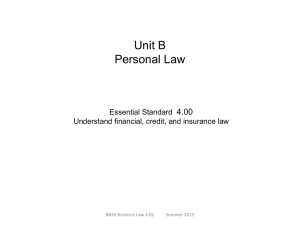Unit B Personal Law - chriswilliams
advertisement
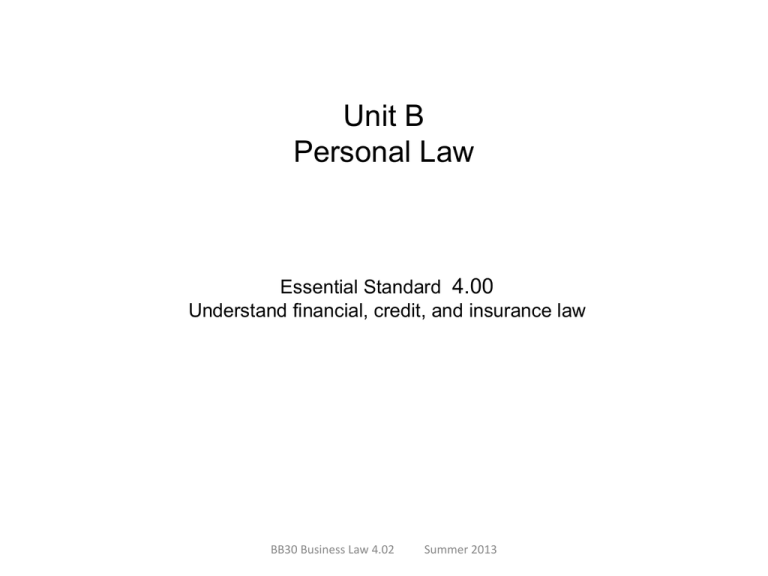
Unit B Personal Law Essential Standard 4.00 Understand financial, credit, and insurance law BB30 Business Law 4.02 Summer 2013 4.02 Understand Types and Aspects of Insurance A. Insurance Defined Premiums 1. What are premiums? 2. What type of insurance types have them? Insurable Interest-Financial Responsibility 1. What determines whether there is an insurable interest? Risk- What is risk and how does it affect BB30 Business Law 4.02 Summer 2013 Insurance Defined-Continued Exclusions 1. What does exclusion mean? 2. How does exclusion apply to insurance? 3. Why do insurance companies put exclusions in their policies? Claims 1. What is a claim in regards to insurance? 2. How does a policy holder enter a claim? BB30 Business Law 4.02 Summer 2013 Insurance Defined (Continued) Deductibles 1. What are deductibles? 2. What is the purpose of a deductible for the policy holder? Insured 1. What or who is the insured 2. Is the insured always the policy holder or not? Insurer 1. Who is an insurer? 2. Is the insurer a business/corporation or an individual? BB30 Business Law 4.02 Summer 2013 Automobile Insurance (http://www.ncdoi.com/_Publications/Consumer%20Guide%20to%20Automobile%20Insurance_CAU1.pdf) a. Personal Auto Policy (PAP) a. Why have a PAP? b. What does it protect you from? b. Liability Coveragea. What are the two types? b. What does it protect you from? c. Property Damage Coverage a. What does it protect you from? b. What is an example of this type of coverage? d. Collision Coverage a. What does it protect you from? b. What is an example of this type of coverage? e. Comprehensive Coverage-Other than Collision a. What does it protect you from? b. What is an example of this type of coverage? c. How is this different collision? BB30from Business Law 4.02 Summer 2013 Automobile Coverage (Continued) f. Medical Payment Coverage(Med Pay) 1. What is medical Payment Coverage? 2. Whom does this coverage pay for in the case of a covered accident? g. Uninsured Motorist Coverage 1. What is uninsured motorist coverage? 2. What are two types of losses that this type of coverage will cover? g. Underinsured Motorist Coverage 1. What is underinsured motorist coverage? 2. Is this coverage mandatory in North Carolina? g. Miscellaneous Coverage-Towing, Rental Vehicle, Custom Coverage 1. Are these types of coverage mandatory for automobile insurance? 2. What does towing coverage provide? 3. What does rental coverage provide? 4. What does custom insurance provide? BB30 Business Law 4.02 Summer 2013 Motorcycle Insurance Liability, Collision, Uninsured/Underinsured and Towing Coverage is identical to a regular automobile policy. It is important to have a special coverage for a customized motorcycle. Traditional motorcycle coverage will only cover the “stock value” not any customizations are added equipment. BB30 Business Law 4.02 Summer 2013 Boat Insurance Pleasure boat policies or endorsements often state that coverage includes "the boat and all permanently attached equipment". The policy may then list items that are not permanently attached, but are covered as either part of the boat's value, or as a separate limit of insurance. Items that may or may not be considered "permanently attached" under a policy include: • Anchors • Batteries • Bilge pumps • Boat furniture • Boat and motor covers • Cook stoves • Deck chairs • Depth finders • Detachable canopies • Emergency signaling devices • Fire extinguishers • Fittings • Fuel tanks • Horns • Life preservers • Lights BB30 Business Law 4.02 Summer 2013 Property Insurance a. Homeowners Insurance Designed to protect the physical assets owned, leased, rented or used by individuals and families. b. Coverage for Property 1. There are (4) basic coverage types within a homeowners policy. 2. Coverage A is for dwelling - located on the residence premises including any attached structures. 3. Coverage B is for other structures - such as a detached garage, workshop, swimming pools, fences and gazebos. 4. Coverage C is Personal Property - anything other than real property (land or anything attached to it). Basically clothing, furniture, televisions. Exceptions: Special items such as money, jewelry, firearms, silverware and other high value metals have loss value limits. 5. Coverage D is for loss of use - Provides money for you and your family to live elsewhere when you cannot live in your home because of a covered loss. BB30 Business Law 4.02 Summer 2013 Homeowner’s Exclusions a. Earth Movement Includes earthquakes, landslides, mudslides etc. b. Water Damage Damage to the home from flooding (requires a separate flood insurance policy if the home is in a flood zone) c. Power Failure If a utility interruption takes place that is not at the insured’s home, coverage is not provided. d. Neglect If the insured fails to use reasonable means to protect the insured property from damage, the loss would not be covered. BB30 Business Law 4.02 Summer 2013 Additional Types of Property Coverage Renters Insurance Offers the same protection as a homeowners policy. Roommates each must have their own renters insurance policy. Fire Insurance Coverage for losses to insured property resulting from fire or lightening, as well as any resulting smoke or water damage. . BB30 Business Law 4.02 Summer 2013 Health Insurance Traditional Health Insurance (Major Medical Coverage) • Contains basic coverage if a catastrophic loss occurs. • To prevent the insured from financial ruin from a long term illness or injury. • Characterized by very high deductibles as high as $10,000 and low premiums. Annual Deductible • A portion of a covered loss not paid by the insurer during the insured’s annual 12 month policy period. • Deductible amount resets each policy year period. Major Exclusions for Coverage • Provision in an insurance policy eliminating coverage for certain risks or otherwise limiting the scope of coverage. • Certain causes and conditions listed in the policy that are not covered. Maternity coverage, major elective surgeries are some examples. BB30 Business Law 4.02 Summer 2013 Health Insurance Possible lengthy waiting periods • Time that elapses after the insured’s policy is active, before specific exclusions will be covered. (Ex. Maternity coverage) Group Insurance Coverage • Coverage provided by a group which is normally the insured’s employer or other inclusive group. • Coverage rates are based on the group’s “experience rating” so that each group pays according to it’s actual claim experience • Almost sixty percent of Americans have group health insurance BB30 Business Law 4.02 Summer 2013 Managed Health Care 1) HMO • Health Maintenance Organization-group managed health insurance where will need to receive most or all of your health care from a provider. • HMOs require that you select a primary care physician (PCP) who is responsible for managing and coordinating all of your health care 2) PPO Preferred Provider Organization (PPO) is a health plan that has contracts with a network of "preferred" providers from which you can choose. You do not need to select a PCP and you do not need referrals to see other providers in the network. 3)HMO-(POS) The POS plan is like a combination of the HMO and PPO plans. You are required to designate an in-network physician to be your primary health care provider. You may go out-of-network if you choose, but in doing so, you will have to pay most of the cost yourself Individual Insurance Coverage Available from most of the same insurer’s that provide group coverage at much higher rates. Less than nine percent of Americans purchase individual health BB30 Business Law 4.02 Summer 2013 insurance. Supplemental Health Insurance Coverage a. Cancer Insurance Coverage Cancer insurance pays benefits only if you're diagnosed with cancer -- not for other illnesses -- and it doesn't cover all your treatment costs. b. Dental Insurance Coverage • Available in group and individual plans. • May have restrictions on certain services, such as orthodontic work. Many Dental plans also have a maximum benefit of around $1,000 to $2,000 per year. • May restrict coverage of pre-existing conditions c. Long Term Medical Coverage Provides for the daily custodial care as well as the long-term nursing care that an individual may need outside of the hospital. BB30 Business Law 4.02 Summer 2013 Health Insurance (Continued) d. Vision Insurance Coverage Optometrists and ophthalmologists in a provider network offer eye exams, eyewear and other services covered by the vision insurance plan at no charge or at discounted fees compared with doctors outside the network. Government Insurance Coverage Medicare(Federal) • Part of the federal Social Security program. Covers most individuals that are age 65 or older. • Can also pay benefits to qualified disabled individuals under age 65 • Covers individuals under age 65 who need long term kidney dialysis treatment or kidney transplants Medicaid (Federal/State) Provides health insurance coverage to low income groups. Coverage varies by each state. BB30 Business Law 4.02 Summer 2013 Medigap (Supplemental Coverage of 20%) Medicare supplement (Medigap) insurance, sold by private companies, can help pay some of the health care costs that original Medicare doesn't cover, like copayments, coinsurance, and deductibles. Disability Insurance Coverage Disability income insurance provides monthly benefits to a disabled wage earner to reimburse the wage earner’s income during a period of total or partial disability. Ex. - AFLAC BB30 Business Law 4.02 Summer 2013 Life Insurance-Types (How Much Do You Need?) Term Insurance • Provides coverage for a specific period. • If the insured dies during the policy term, death benefit paid to beneficiary. • Lower premium than whole life, universal life policies for higher coverage. Increasing Term Insurance Because mortality rates increase with age, the likelihood of dying does too. Therefore the term insurance premiums also increase Decreasing Term Insurance In the early years of a decreasing term policy, the death benefit will be the face amount of the policy when purchased. As years pass, the death benefit will decline. BB30 Business Law 4.02 Summer 2013 Life Insurance (continued) Level Term Insurance Fixed annual premium for a fixed number of years. Permanent Life Insurance a) Whole Life Insurance-provides lifetime protection, accrues a cash value and has premiums that remain unchanged during the insured’s lifetime. b) Universal Life Insurance-Similar to whole life insurance, but it has flexible premiums that can be increased or decreased based on the insured’s needs. c) Variable Life Insurance-similar to universal life insurance but the insured can control where the policy cash value is invested with any capital gains tax liability. BB30 Business Law 4.02 Summer 2013 Life Insurance (Continued) Life Insurance Optional Rider Coverage Riders are attachments to existing policies for additional coverage for family members (spouses/dependent children). Guaranteed Insurability Usually added free to most term life insurance policies and means the policy can be altered without the need to reapply and prove your insurability. Accidental Death and Dismemberment In the event of an accidental death, this insurance will pay benefits in addition to any life insurance but only up to a set amount. Dismemberment - Fractional amounts of the policy will be paid out if the insured loses a bodily appendage or sight because of an accident. BB30 Business Law 4.02 Summer 2013 Life Insurance (Continued) Beneficiaries Recipient of the proceeds of the policy when the named insured dies. Contingent Beneficiary Contingent (or secondary) beneficiary is entitled to the policy proceeds if the primary beneficiary has predeceased the insured. Collecting Death Benefits Apply for the proceeds simply by filling out the insurance company's claim form and submitting it to the company along with a certified copy of the death certificate. BB30 Business Law 4.02 Summer 2013 Life Insurance (Continued) Cost factors Needs Approach - Determine the total financial requirements of the insured’s surviving dependent family. How much will it take for the insured’s family to live Human Life Value Approach - Objective is to determine the total amount of income that will be lost when the primary earner dies. How much is a person worth Statistical Basis for Life Insurance Mortality tables provide probabilities based on deaths per 1,000 living that are expected to die in a given year. (Ex: A 17 year old male has a life expectancy of 58.94 years or age 75.94) Morbidity tables show the rate of disease, illness or sickness among groups of people according to age or other factors such as gender or occupation. BB30 Business Law 4.02 Summer 2013 Insurance Fraud Automobile Repair Billing of Medical Services Automobile Accidents Property Claims Adjusting BB30 Business Law 4.02 Summer 2013
